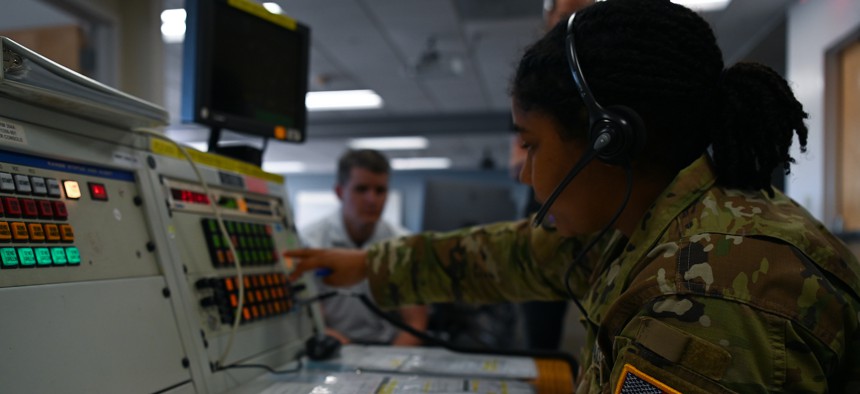
2nd Lt. Taylor Latimer, 2nd Range Operations Squadron range operations commander, walks industry partners through a simulated console exercise at Vandenberg Space Force Base, Calif., June 24, 2022. U.S. Space Force / Airman 1st Class Tiarra Sibley
Defense officials tease new commercial space strategies
The documents would detail how the Pentagon and Space Force want to use private space companies for military missions.
The Pentagon and Space Force are preparing commercial space strategies that could come early next month, officials said, to officially recognize the increased role private space companies play in national defense.
“I know I've been saying this for a while, but there is a commercial space strategy that is almost ready for delivery. And I feel like I've built this up to a crescendo now where you're expecting just everything that could possibly be wanted in this document. But it is coming soon,” Chief of Space Operations Gen. Chance Saltzman said Wednesday at the Mitchell Institute’s Spacepower Security Symposium.
The Pentagon and the Space Force are putting the final touches on their strategies, but they could be ready by early April, Saltzman hinted.
“I expect to talk about it in any detail at the Space Symposium out in Colorado Springs in a couple of weeks,” he said. “I think you'll see in there—at least categorically—where we think in a prioritized way, where commercial industry can provide the best value to us as a Space Force, what our needs are. And if it doesn't give you some insights, that will come back and tell me no, we'll fix it.”
The strategies are coming as the Defense Department deepens its relationships with commercial space companies like SpaceX.
“I think the work that SpaceX has done with the Starship is groundbreaking,” Saltzman said. “We've had big rockets before they’ve put heavy payloads on. But now you're talking about a commercially viable product, which could change the cost for a decision.”
The Space Force’s budget request for 2025 is somewhat flat at nearly $ $29.4 billion—that’s $600 million less than last year’s request, thanks to budget caps. But the topline hit worried Air Force Secretary Frank Kendall, who said that the budget, while sufficient to keep key programs running, isn’t enough to keep pace with China.
Saltzman stressed that all of the services were affected by budget caps and, for what it’s worth, the Spaces Force has seen continuous growth in recent years—about a 10 percent bump from 2023 to 2024.
“You do the best you can,” Saltzman said. “Do I need more? Probably. Do I want more? Absolutely.”
But when it comes to using commercial capability, Saltzman said he wants to watch and learn what’s possible.
“Because if I would try to define the requirements, it would fall so short of what you're really capable as an industry, and startups, of doing. I would never have written requirements for Starship.”
John Plumb, the Pentagon’s assistant secretary of defense for space policy, said industry can provide “deeper integration into our systems to really make a difference across the board.” But there’s also concern about cyber threats.
“How cyber hard is your constellation is a concern I have, because what we need is not a thing that just works in peacetime, which is nice. What the department needs [are] things that also work in war,” Plumb said.
And as Maj. Gen. Gregory Gagnon, deputy chief of space operations for intelligence, put it during his panel: “How can you help us avoid operational surprise? You can protect your cyber networks and your intellectual property, because I, for one, am tired of seeing carbon copies of U.S. intellectual property on airfields and in other places in China. So help us help you.”
